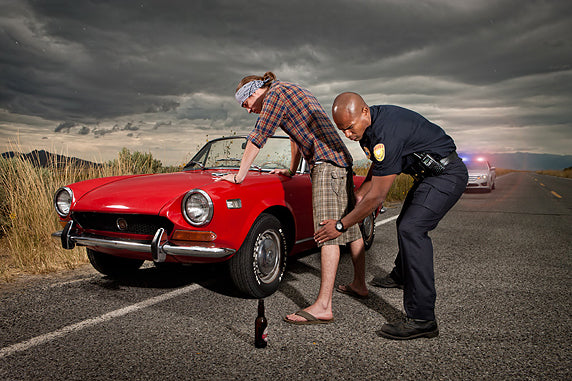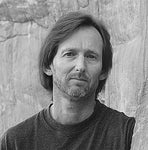Jacom Stephens (jacomstephens.com) is an award-winning commercial photographer based out of Salt Lake City with nearly twenty years of experience in the advertising industry. He has worked for many local and national brands and has built a reputation of creating stunning, impeccably lit images. Jacom specializes in on-location lifestyle photography, typically of people using products in various situations, but does a fair amount of architectural and product photography as well. A master of lighting, Jacom's photography is bright and upbeat, and his images have a clarity and quality that just make them pop. He brings to his work an intrinsic appreciation of beauty, a passion for creating, attention to detail, and the ability to flawlessly execute elaborate shots.
Jacom: "Last year I was working for an ad agency on a shoot for Kenwood, and although the job only called for simple product photos of about two dozen handheld radios, I really wanted to upsell the client to hire me to create lifestyle images for the various markets they serve… images of people actually using the radios in real world situations that could be used as supplemental images for their website, product catalog, and magazine ads. The ad agency didn't bite on the initial sales pitch, so I decided that since I would have the radios on hand for the product shoot, I would go ahead and use them to create a handful of lifestyle images on my own dime to hopefully get the client salivating and encourage them to sign off on the concept."
"Kenwood's radios are used in a wide variety of markets, but I chose to focus on the law enforcement industry for this conceptual shoot. I had several specific shots in mind, one of which was a dark, moody shot of a drunk driver being pulled over on the side of the road that would emphasize the adverse side-effects of drinking without portraying the officer in a negative way. In my opinion, there is a big difference between creating an image as opposed to capturing an image. As a commercial photographer, it is important to be able to pre-visualize the shot as communicated by the art director or from your own imagination, and then to be able to go out and produce that image as close as possible to the original vision. So let's talk about what went into creating this image."
PREP WORK FOR THE SHOT
"There was a fair amount of prep work for this shot. I needed to find a location with a long, open stretch of road with minimal traffic, and then cast models who fit the part. I had my assistant design a generic beer bottle label so that the image would't cast a negative connotation on any particular brewing company, as well as creating generic police patches so they wouldn't infringe on any copyrights or imply endorsement by any particular law enforcement agency. We had to buy police uniforms and badges (which is harder than you'd think without law enforcement credentials), an equipment belt with holster and handgun, and then rent or borrow several different vehicles for the shoot. I also ended up adjusting our schedule to match the weather, which proved to be essential for the impact of this final image."
THE SETUP
"We used four Elinchrom Ranger high-powered battery strobes to provide the lighting. The main light source is at camera right with a large Octabox softbox, and to camera left there is another strobe with a diffused beauty dish. In the background, we used two gelled strobes with reflector cones positioned behind the silver 'police' car to simulate a red and blue light bar since the only actual police vehicle we could get on short notice was a modern highway patrol pickup truck. For scheduling reasons and to be able to control the amount of ambient light, this shot was done in mid afternoon, but I wanted it to look sullen and like it was shot at dusk, so I used a variable neutral density filter on the camera to darken the ambient light about 2-3 stops. This also had the desired effect of changing the fairly flat white cloud cover into a more dramatic and moody sky."
"After we had set all of this up and had the lights dialed in, I called in the models and explained what I wanted them to do, and then I started shooting. I got off three shots and then with hardly any warning the heavens opened and a very heavy rainfall crashed down, so we had to stop immediately and run around putting away lighting equipment before it was damaged in the downpour. It turned out to be perfect timing for the visual impact of the storm clouds, but I wish I would have had more than just 20-30 seconds in order to develop the shot a bit further. It just goes to show that as a professional photographer (especially when shooting on location), you need to be able to execute the shot under pressure and tight schedules, and need to be able to adapt to the situation as it changes."
POST-PRODUCTION
"Other than basic levels, tone curves, and localized cleanup of scratches on the vehicle and skin blemishes, the only Photoshop work I did was to add the subtle lens flare to the police light bar in the background. I occasionally do dramatic alterations in post, but for the most part, I prefer to create as much of an image in camera as possible."
IN RETROSPECT
"I am of the opinion that if you look back at the images you shot in previous years and can't see things you would improve, then you aren't pushing yourself hard enough to further your skills. But if you look back at your past work and say 'I could do that shot better now', then you have grown. And if you're not moving forward, you're moving backward and are no longer as competitive in the marketplace."
"So what would I have done differently on this shot? Unless you view the image at 100%, you can't really see the raindrops in the sky, but by default the PocketWizards were set on first curtain sync, which flashes the rain drops and then leaves a tail below the drop. This, of course, isn't the best. If I had anticipated having rain falling in the image, I would have set the lights to fire on the rear curtain so that the motion trail on the raindrops would be going in the correct direction."
"I should have also moved the position of the beer bottle a bit to avoid the point of tangency between the top of the beer bottle and the tire. I could have turned the running lights or headlights on the red car and I would have liked to have an actual police car in the background with a push bar on the front. All of those points are pretty minor, but for a perfectionist like me, they bug me. And in my opinion it's a healthy habit to analyze your shots and identify how you could improve them for next time."
THE RESULT
"When I presented the concept images to the ad agency, they loved them and sent them off to Kenwood with a request for additional photography budget. It was approved and a couple of months later I was on my way to British Columbia for a week long shoot to generate lifestyle images for half a dozen vertical markets that Kenwood's radios cover including trucking, fire fighting, hotel and lodging, event security, manufacturing, search and rescue, and logging. Kenwood never did end up buying the police images so I licensed them as stock to recoup my financial investment in creating them, but the shoot served it's purpose of getting additional contract work from Kenwood."
JACOM'S EQUIPMENT FOR THE SHOT:
Camera: Canon 1Ds Mark III
Lens: Canon 24-70 mm f/2.8L USM
Settings: ISO 100, f/6.3, 1/125 of a second
Other: Elinchrom Ranger RX Speed AS, Elinchrom Rotalux 53" Octagonal Softbox, Elinchrom Softlite Reflector beauty dish, PocketWizard TT1 and TT5's, Singh-Ray variable neutral density filter
Stay connected to Jacom: Website | Facebook
RELATED ARTICLES
Eric Meola: Travel Images since "Last Places on Earth"
PatitucciPhoto and the Pushkar Festival
How I Got That Shot - Mike Tittel's Mountain Biking Photograph




